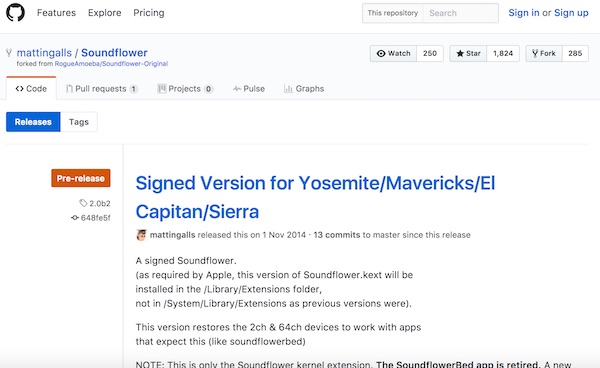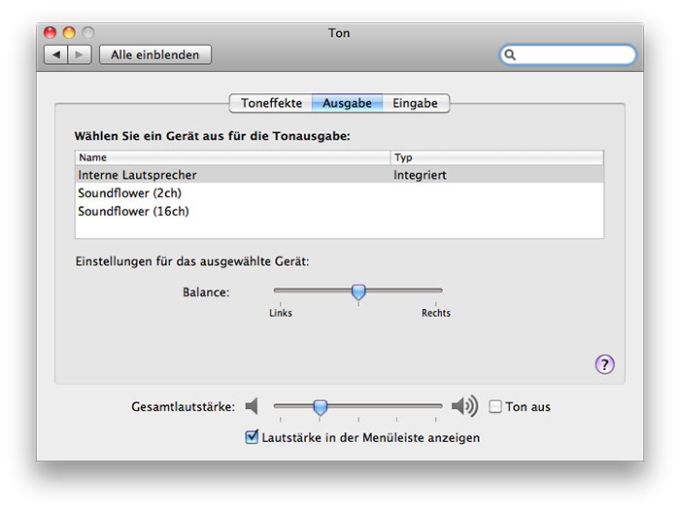
- #Install soundflower mac how to
- #Install soundflower mac for mac
- #Install soundflower mac full
You should open the System Preferences menu to choose the Security & Privacy settings to unblock the installation from the website. Step 2 It is normal that the Soundflower installation failed.

After that, you can run it and perform the install.
#Install soundflower mac for mac
Step 1 Search for the Soundflower for Mac extension from the web browser, you can download and install the latest Soundflower 2.0b2 from Filehorse or Softonic. Just check out the detailed process as below. Just as mentioned above, Soundflower for Mac is only a macOS Kernel extension, which you cannot download directly from the App Store as the other Mac applications. After that, you can the method to record audio files with Soundflower for Mac. When you need to record audio from different channels on your Mac, you should download the audio recorder to your MacBook beforehand.
#Install soundflower mac how to
Part 1: How to Record Audio Files with Soundflower for Mac
Part 2: Best Soundflower for Mac Alternative to Record Audio. Part 1: How to Record Audio Files with Soundflower for Mac. Here you can find how it works and the best alternative from the article. Whether you need to record the in-built sound of your MacBook, or capture audio from any profession device, Soundflower for Mac should be one of the best choices you can take into consideration. #Install soundflower mac full
Soundflower for Mac is a macOS Kernel extension that can create a virtual audio device with full support for inputting and outputting sound to any of your active apps. dmg, download it again and you’ll be able to find the uninstaller.“What should I do if I want to record the system sound via QuickTime? How to capture audio with Soundflower for Mac? It is compatible with macOS Mojave of my MacBook?” Uninstalling Soundflower is just a matter of remounting the DMG again, then running the “Uninstall Soundflower.scpt” file that resides there. You can use either Soundflower 2channel or Soundflower 64 channel, just be sure to match them up for both audio input and output.
 In the recording application, always select the Audio Input (microphone setting) to “Soundflower”. Always set the System-level Audio Output to “Soundflower”. There are two important things to remember when recording audio output with Soundflower that will apply to any application you use to capture audio: Play back the audio to find whatever the output was is now perfectly captured. Click the red “Record” button in Audacity to start capturing the playing audio, click “Stop” or “Pause” when finished. Start playing the audio you wish to capture. Launch Audacity and change the audio input to “Soundflower”. Option-Click the Volume menu and send Output to “Soundflower”. We’ll walk through how to record any audio with Audacity: Nonetheless, all you’ll need to do to capture audio output is to select Soundflower as the sound channel(s) when capturing audio using whichever app you are using, whether it’s Garageband or something like the freeware Audacity app. Be sure to check those rights before capturing audio. Keep in mind that most audio recordings are subjected to their own usage and rights laws, each of which will probably differ depending on the owner and distributor of the audio. Recording System Audio Output with SoundflowerĪt this point you are able to record any system level audio output using whichever app is appropriate. Notice how the audio will cut in or out depending on which output setting is chosen. The brief video below demonstrates audio channels being redirected from iTunes through Soundflower, which are then able to be picked up by the screen recording application QuickTime: Start playing any audio, then look within the Input tab of Sound prefs to find the “Input Level” indicator is moving to the sounds of the the system audio which is now being transported through Soundflower, rather than the general output speakers and input microphone.
In the recording application, always select the Audio Input (microphone setting) to “Soundflower”. Always set the System-level Audio Output to “Soundflower”. There are two important things to remember when recording audio output with Soundflower that will apply to any application you use to capture audio: Play back the audio to find whatever the output was is now perfectly captured. Click the red “Record” button in Audacity to start capturing the playing audio, click “Stop” or “Pause” when finished. Start playing the audio you wish to capture. Launch Audacity and change the audio input to “Soundflower”. Option-Click the Volume menu and send Output to “Soundflower”. We’ll walk through how to record any audio with Audacity: Nonetheless, all you’ll need to do to capture audio output is to select Soundflower as the sound channel(s) when capturing audio using whichever app you are using, whether it’s Garageband or something like the freeware Audacity app. Be sure to check those rights before capturing audio. Keep in mind that most audio recordings are subjected to their own usage and rights laws, each of which will probably differ depending on the owner and distributor of the audio. Recording System Audio Output with SoundflowerĪt this point you are able to record any system level audio output using whichever app is appropriate. Notice how the audio will cut in or out depending on which output setting is chosen. The brief video below demonstrates audio channels being redirected from iTunes through Soundflower, which are then able to be picked up by the screen recording application QuickTime: Start playing any audio, then look within the Input tab of Sound prefs to find the “Input Level” indicator is moving to the sounds of the the system audio which is now being transported through Soundflower, rather than the general output speakers and input microphone. 
Once Soundflower has been installed, you can also quickly adjust audio input and output by option+clicking the Volume menu and selecting Soundflower as the audio input, output, or both from there too.Ī quick way to test and confirm that Soundflower is working is if you start playing system audio with Soundflower now set as both input and output sources. Setting Soundflower to both output and input gives a direct line from system audio output to system audio input, but you can obviously adjust those settings as appropriate for your needs.
Next, under “Input” tab, again select “Soundflower” (for testing purposes, adjust this later for your own needs on a per application basis). Pull down the Apple menu and open System Preferences, then go to “Sound”. Mount the DMG and install Soundflower, then reboot the Mac to complete installation. Soundflower is required to be able to send audio output channels into the audio input.







 0 kommentar(er)
0 kommentar(er)
